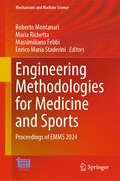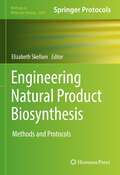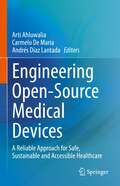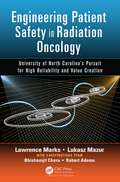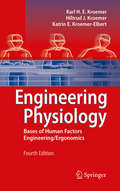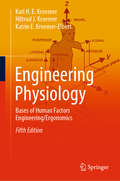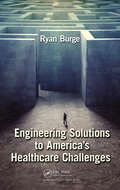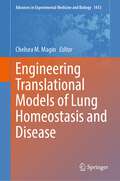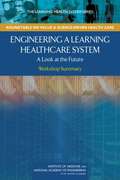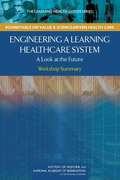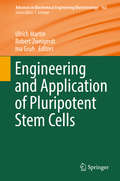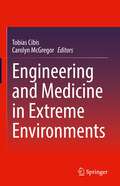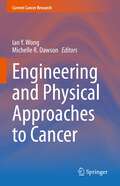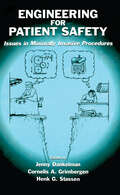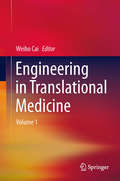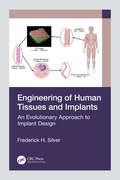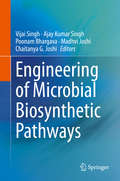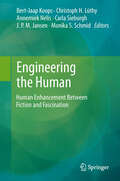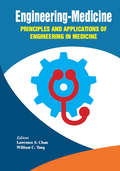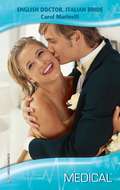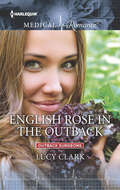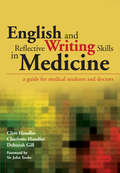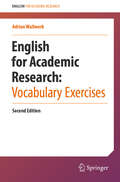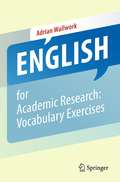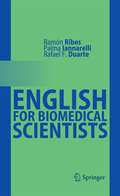- Table View
- List View
Engineering Methodologies for Medicine and Sports: Proceedings of EMMS 2024 (Mechanisms and Machine Science #162)
by Roberto Montanari Maria Richetta Massimiliano Febbi Enrico Maria StaderiniThis book presents the proceedings of the International Workshop on Engineering Methodologies for Medicine and Sports (EMMS), held in Rome, Italy on February 7-9, 2024. It includes peer-reviewed papers on emerging engineering methodologies applied to biomedicine and sports, discussing topics such as advanced biomaterials, biodegradable implants, additive manufacturing of prosthesis, surface design, fabrication of bioreactors, design of biomechanical devices, rehabilitation and prevention, AI applications to medicine, biosensors, medical signal analysis, medical sensors, detection and monitoring of substances dangerous for health, biomechanics, assessment of sport performance, sport activity as a diagnostic device. A valuable, up-to-date resource, it offers an essential overview of the subject for scientists and practitioners alike, and will inspire further investigations and research.
Engineering Natural Product Biosynthesis: Methods and Protocols (Methods in Molecular Biology #2489)
by Elizabeth SkellamThis volume highlights natural products, molecular methods for identifying, and current trends in designing non-natural natural products. Chapters guide readers through protocols on heterologous expression techniques, gene disruption, modified pathway regulators, and in-vitro studies. Written in the format of the highly successful Methods in Molecular Biology series, each chapter includes an introduction to the topic, lists necessary materials and reagents, includes tips on troubleshooting and known pitfalls, and step-by-step, readily reproducible protocols. Authoritative and cutting-edge, Engineering Natural Product Biosynthesis: Methods and Protocols aims to be a useful and practical guide to new researchers and experts looking to expand their knowledge. Chapter 13 is available open access under a Creative Commons Attribution 4.0 International License via link.springer.com.
Engineering Open-Source Medical Devices: A Reliable Approach for Safe, Sustainable and Accessible Healthcare
by Andrés Díaz Lantada Arti Ahluwalia Carmelo De MariaThis book focuses on the challenges and potentials of open source and collaborative design approaches and strategies in the biomedical field. It provides a comprehensive set of good practices and methods for making these safe, innovative and certifiable biomedical devices reach patients and provide successful solutions to healthcare issues. The chapters are sequenced to follow the complete lifecycle of open source medical technologies. The information provided is eminently practical, as it is supported by real cases of study, in which collaboration among medical professionals, engineers and technicians, patients and patient associations, policy makers, regulatory bodies, and citizens has proven beneficial. The book is also supported by an online infrastructure, UBORA, through which open-source medical devices can be collaboratively developed and shared for the democratization of medical technology and for promoting accessible biomedical engineering education.
Engineering Patient Safety in Radiation Oncology: University of North Carolina's Pursuit for High Reliability and Value Creation
by Robert Adams Lukasz Mazur Lawrence Marks Bhishamjit CheraBecause radiation is a central curative and palliative therapy for many patients, it is essential to have safe and efficient systems for planning and delivering radiation therapy. Factors such as rapid technological advances, financial reorganization, an aging population, and evolving societal expectations, however, may be compromising our ability
Engineering Physiology
by Karl H. Kroemer Hiltrud J. Kroemer Katrin E. Kroemer-ElbertThis book discusses the architecture, functioning, and biomechanics of the human body, its bones, joints, muscles, tendons, and ligaments. The book explains energy extraction from food and drink, what efforts the body is capable of, and how our efforts depend on the coordination among the respiratory, circulatory, and metabolic systems. This text shows how the body monitors itself, how it reacts to work loads and the environment such as heat or cold, humidity and wind. The book also explains how to measure a person's ability to work at high efficiency: by observation of breathing rate, heart beat frequency, oxygen consumption, and by careful evaluation of subjective judgements.The text discusses, in practical terms, effects of environmental conditions and how shift work arrangements during day, evening, and night affect task performance.
Engineering Physiology: Bases of Human Factors Engineering/ Ergonomics
by Karl H. Kroemer Hiltrud J. Kroemer Katrin E. Kroemer-ElbertThis fifth edition of “Engineering Physiology” has the same purpose as the earlier prints: to provide physiological information which engineers, designers, supervisors, managers and other planners need to make work and equipment “fit the human.” Chapters have been revised, figures and tables updated. New material discusses, among other topics, models of the human body that provide practical and design-oriented information, biomechanics describing the body’s capabilities and limitations, effects of shift work / sleep loss on attitude and performance, and new techniques to measure body sizes and the resultant changes in applications of that information. The book does not replace standard (biological-medical-chemical) textbooks on human physiology; instead, it provides information on human features and functions which are basic to ergonomics or human (factors) engineering, terms often used interchangeably. It helps lay the foundations for teamwork among engineers and physiologists, biologists and physicians. Bioengineering topics concern bones and tissues, neural networks, biochemical processes, bio- and anthromechanics, biosensors, perception of information and related actions, to mention just a few areas of common interest. Such understanding provides the underpinnings for devising work tasks, tools, workplaces, vehicles, work-rest schedules, human-machine systems, homes and designed environments so that we humans can work and live safely, efficiently and comfortably.
Engineering Solutions to America's Healthcare Challenges
by Ryan BurgeEngineering Solutions to America‘s Healthcare Challenges covers the technologies, systems, and processes that are emerging in hospitals, clinics, community centers, universities, and the White House to repair healthcare in the United States. Focusing on the importance of individuals being proactive about their own state of health, it presents a sys
Engineering Translational Models of Lung Homeostasis and Disease (Advances in Experimental Medicine and Biology #1413)
by Chelsea M. MaginCutting-edge engineering approaches towards modelling lung homeostasis and disease have created dynamic new opportunities for interdisciplinary collaboration and unprecedented progress toward understanding and treating lung disease. This text connects established research in lung biology and physiology to innovative engineering strategies for pulmonary modelling. This unique approach aims to encourage and facilitate progress among a greater audience of basic and translational scientists, clinicians, and medical practitioners. Engineering Translational Models of Lung Homeostasis and Disease illustrates the advances in lung tissue characterization, revealing dynamic changes in the structure, mechanics, and composition of the extracellular matrix. This information paves the way for tissue-informed engineering models of pulmonary tissue, improved design of clinical materials, and advances against a variety of common pathologies. Current translational challenges are highlighted, as are engineering opportunities to overcome these barriers. This foundational text holds valuable lessons for researchers and clinicians throughout the fields of engineering, materials science, cell biology, pulmonary medicine, and clinical science.· Each section focuses on a specific region of the lung, presenting either the biological or clinical perspective along with complimentary engineering approaches · Covers the interface of engineering and lung biology · Highlights emerging new models to study lung disease and repair
Engineering a Learning Healthcare System: Workshop Summary
by Claudia GrossmannImproving our nation's healthcare system is a challenge which, because of its scale and complexity, requires a creative approach and input from many different fields of expertise. Lessons from engineering have the potential to improve both the efficiency and quality of healthcare delivery. The fundamental notion of a high-performing healthcare system--one that increasingly is more effective, more efficient, safer, and higher quality--is rooted in continuous improvement principles that medicine shares with engineering. As part of its Learning Health System series of workshops, the Institute of Medicine's Roundtable on Value and Science-Driven Health Care and the National Academy of Engineering, hosted a workshop on lessons from systems and operations engineering that could be applied to health care. Building on previous work done in this area the workshop convened leading engineering practitioners, health professionals, and scholars to explore how the field might learn from and apply systems engineering principles in the design of a learning healthcare system. Engineering a Learning Healthcare System: A Look at the Future: Workshop Summary focuses on current major healthcare system challenges and what the field of engineering has to offer in the redesign of the system toward a learning healthcare system.
Engineering a Learninghealthcare System
by The National Academy of SciencesImproving our nation's healthcare system is a challenge which, because of its scale and complexity, requires a creative approach and input from many different fields of expertise. Lessons from engineering have the potential to improve both the efficiency and quality of healthcare delivery. The fundamental notion of a high-performing healthcare system--one that increasingly is more effective, more efficient, safer, and higher quality--is rooted in continuous improvement principles that medicine shares with engineering. As part of its Learning Health System series of workshops, the Institute of Medicine's Roundtable on Value and Science-Driven Health Care and the National Academy of Engineering, hosted a workshop on lessons from systems and operations engineering that could be applied to health care. Building on previous work done in this area the workshop convened leading engineering practitioners, health professionals, and scholars to explore how the field might learn from and apply systems engineering principles in the design of a learning healthcare system. Engineering a Learning Healthcare System: A Look at the Future: Workshop Summaryfocuses on current major healthcare system challenges and what the field of engineering has to offer in the redesign of the system toward a learning healthcare system.
Engineering and Application of Pluripotent Stem Cells (Advances in Biochemical Engineering/Biotechnology #163)
by Ulrich Martin Robert Zweigerdt Ina GruhThis book reviews the latest biotechnological advances with pluripotent stem cells, exploring their application in tissue engineering and medicinal chemistry. Chapters from expert contributors cover topics such as the production of transgene-free induced pluripotent stem cells (iPSCs), expansion, controlled differentiation and programming of pluripotent stem cells, and their genetic instability. Particular attention is given to the application of the pluripotent stem cells for vascularision of engineered tissue and for drug screening.This book will appeal to researchers working in regenerative medicine and drug discovery, and to bioengineers and professionals interested in stem cell research.
Engineering and Medicine in Extreme Environments
by Tobias Cibis Carolyn McGregor AmThis book brings together in-depth information on a wide array of bio-engineering topics and their application to enhance human health, performance, comfort, and survival in extreme environments. Contributions from biomedical engineering, information systems, medicine and physiology, and medical engineering are presented in relation to a broad range of harsh and extreme environmental scenarios, including underwater, terrestrial (both natural and man-made), and space travel. Physicians, engineers, and scientists, as well as researchers and graduate students, will find the book to be an invaluable resource.Details effects of extreme environments on human physiology;Presents human-environment interaction in different scenarios;Overview of engineering challenges and problems in extreme environments.
Engineering and Physical Approaches to Cancer (Current Cancer Research)
by Ian Y. Wong Michelle R. DawsonEngineering and Physical Approaches to Cancer addresses the newest research at this interface between cancer biology and the physical sciences. Several chapters address the mechanobiology of collective and individual cell migration, including experimental, theoretical, and computational perspectives. Other chapters consider the crosstalk of biological, chemical, and physical cues in the tumor microenvironment, including the role of senescence, polyploid giant cells, TGF-beta, metabolism, and immune cells. Further, chapters focus on circulating tumor cells and metastatic colonization, highlighting both bioengineered models as well as diagnostic technologies. Further, this book features the work of emerging and diverse investigators in this field, who have already made impressive cross-disciplinary scientific contributions. This book is designed for a general audience, particularly researchers conversant in cancer biology but less familiar with engineering (and vice-versa). Thus, we envision that this book will be suitable for faculty, postdoctoral fellows, and advanced graduate students across medicine, biological sciences, and engineering. We also anticipate this book will be of interest to medical professionals and trainees, as well as researchers in the pharmaceutical and biomedical device industry.Describes physical aspects of cancer, including collective cell migration, the aberrant tumor microenvironment, circulating tumor cells, and metastatic colonization. First volume available on the topic of physical aspects of cancer
Engineering for Patient Safety: Issues in Minimally Invasive Procedures (Human Error and Safety)
by Jenny Dankelman Henk G. Stassen Comelis A. GrimbergenThis is a brief study of how human factors engineers have worked with medical personnel to improve patient safety and reduce medical error in the newest minimally invasive surgical procedures (laparoscopy, angioplasty, colonoscopy, etc).
Engineering in Translational Medicine
by Weibo CaiThis book covers a broad area of engineering research in translational medicine. Leaders in academic institutions around the world contributed focused chapters on a broad array of topics such as: cell and tissue engineering (6 chapters), genetic and protein engineering (10 chapters), nanoengineering (10 chapters), biomedical instrumentation (4 chapters), and theranostics and other novel approaches (4 chapters). Each chapter is a stand-alone review that summarizes the state-of-the-art of the specific research area. Engineering in Translational Medicine gives readers a comprehensive and in-depth overview of a broad array of related research areas, making this an excellent reference book for scientists and students both new to engineering/translational medicine and currently working in this area. The ability for engineering approaches to change biomedical research are increasing and having significant impact. Development of basic assays and their numerous applications are allowing for many new discoveries and should eventually impact human health. This book brings together many diverse yet related topics to give the reader a solid overview of many important areas that are not found together elsewhere. Dr. Weibo Cai has taken great care to select key research leaders of many sub-disciplines who have put together very detailed chapters that are easy to read yet highly rich in content. _______________ This book brings together many diverse yet related topics to give the reader a solid overview of many important areas that are not found together elsewhere. Dr. Weibo Cai has taken great care to select key research leaders of many sub-disciplines who have put together very detailed chapters that are easy to read yet highly rich in content. It is very exciting to see such a great set of chapters all together to allow one to have a key understanding of many different areas including cell, gene, protein, and nano engineering as well as the emerging field of theranostics. I am sure the readers will find this collection of important chapters helpful in their own research and understanding of how engineering has and will continue to play a critical role in biomedical research and clinical translation Sanjiv Sam Gambhir M. D. , Ph. D. Stanford University, USA Engineering in Translational Medicine is a landmark book bridging the fields of engineering and medicine with a focus on translational technologies and methods. In a single, well-coordinated volume, this book brings together contributions from a strong and international scientific cast, broadly covering the topics. The book captures the tremendous opportunities made possible by recent developments in bioengineering, and highlights the potential impact of these advances across a broad spectrum of pressing health care needs. The book can equally serve as a text for graduate level courses, a reference source, a book to be dipped into for pleasure by those working within the field, or a cover-to-cover read for those wanting a comprehensive, yet readable introduction to the current state of engineering advances and how they are impacting translational medicine Simon R. Cherry, Ph. D. University of California, Davis, USA
Engineering of Human Tissues and Implants: An Evolutionary Approach to Implant Design
by Frederick H. SilverThis text presents information on biological control systems, mechanotransduction, tissue structure, and function, as well as properties that can be integrated together to provide improved implant and device designs. This information is needed to develop new diagnostic tests and instruments that provide early diagnostic tests and treatments for diseases.Engineering of Human Tissues and Implants: An Evolutionary Approach to Implant Design provides basic scientific information on the evolutionary design of tissues and organs that are a result of living in a gravitational field. Much of the useful information that is available for the design of implants is based on tissue structure and function derived from light and electron microscopy observations. However, this information is not enough for developing new designs of implants and medical devices since much of the biological response to implants is based on understanding the biological control systems and mechanotransduction that drive many of the responses seen with implanted devices. The book also introduces mechanotransduction as it relates to implant design with an overview of materials and their use in applications that include those materials designed to treat wounds, burns, facial, hernial, ophthalmic, oral, cardiovascular, and tendon/ligaments.This book is intended for biomedical science and engineering students who are learning about artificial implants and medical device development. It will also be of significance to other engineering majors interested in the design of devices for diagnoses and measuring of physiological parameters, as well as to clinicians and researchers who are interested in mechanobiology.
Engineering of Microbial Biosynthetic Pathways
by Ajay Kumar Singh Vijai Singh Poonam Bhargava Madhvi Joshi Chaitanya G. JoshiThis book provides a comprehensive overview of the basic and advanced metabolic engineering technologies used to generate natural metabolites and industrially important biomolecules. Metabolic engineering has the potential to produce large quantities of valuable biomolecules in a renewable and sustainable manner by extending or modifying biosynthetic pathways in a wide range of organisms. It has been successfully used to produce chemicals, drugs, enzymes, amino acids, antibiotics, biofuels, and industrially important pharmaceuticals. The book comprehensively reviews the various metabolites detection, extraction and biosensors and the metabolic engineering of microbial strains for the production of industrially useful enzymes, proteins, organic acids, vitamins and antibiotics, therapeutics, chemicals, and biofuels. It also discusses various genetic engineering and synthetic biology tools for metabolic engineering. In closing, the book discusses ethical, patenting and regulatory issues in the metabolic engineering of microbes. This book is a valuable source not only for beginners in metabolic engineering, but also students, researchers, biotechnology and metabolic engineering based company.
Engineering the Human
by Monika S. Schmid Carla Sieburgh Bert Jaap Koops J.P.M. Jansen Annemiek Nelis Christoph H. LüthyThe volume is collection of articles treating the topic of human improvement/enhancement from a variety of perspectives - philosophical, literary, medical, genetic, sociological, legal etc. The chapters in this volume treat not only those aspects that most immediately come to mind when one thinks of 'human enhancement', such as genetic engineering, cloning, artificial implants and artificial intelligence etc. Somewhat less obvious aspects include evolutionary perspectives in connection with the prolongation of the human lifespan, plastic surgery since its beginnings, and questions such as whether the distinction between 'natural' and 'artificial' can really be drawn at all and how it has been conceived across the ages, or what the legal implications are of recent developments and techniques. Many papers make links to the representation of these developments in popular culture, from Jules Verne through Aldous Huxley to the movie Gattaca, address the hopes and fears that come with them as well as the question how realistic these are. While all chapters are written by scientists at the international top of their respective fields, all are accessible to a non-specialist audience and eminently readable. We believe that they represent a state-of-the art overview of questions that are of interest to a large audience. The book thus targets a non-specialist audience with an interest in philosophical, sociological, scientific and legal issues involved in both traditional and recent matters concerning the desire of mankind to improve itself, the human body, the human mind and the human condition. It is unique in that it brings together all these aspects within a coherent and cohesive collection.
Engineering-Medicine: Principles and Applications of Engineering in Medicine
by Lawrence S. Chan and William C. TangThis transformative textbook, first of its kind to incorporate engineering principles into medical education and practice, will be a useful tool for physicians, medical students, biomedical engineers, biomedical engineering students, and healthcare executives. The central approach of the proposed textbook is to provide principles of engineering as applied to medicine and guide the medical students and physicians in achieving the goal of solving medical problems by engineering principles and methodologies. For the medical students and physicians, this proposed textbook will train them to “think like an engineer and act as a physician”. The textbook contains a variety of teaching techniques including class lectures, small group discussions, group projects, and individual projects, with the goals of not just helping students and professionals to understand the principles and methods of engineering, but also guiding students and professionals to develop real-life solutions. For the biomedical engineers and biomedical engineering students, this proposed textbook will give them a large framework and global perspective of how engineering principles could positively impact real-life medicine. To the healthcare executives, the goal of this book is to provide them general guidance and specific examples of applying engineering principles in implementing solution-oriented methodology to their healthcare enterprises. Overall goals of this book are to help improve the overall quality and efficiency of healthcare delivery and outcomes.
English Doctor, Italian Bride
by Carol MarinelliSix years ago, English consultant Hugh Armstrong was welcomed into the Azetti family when he was far from home, and he unwittingly stole the heart of their youngest daughter, Bonny. Their passion culminated in one earth-shattering kiss. Hugh, realizing that seducing their daughter was no way to repay the family for their kindness, quickly retreated to England. Now Hugh has returned to Australia, and not only is he the heartthrob of the emergency department, he is also Nurse Bonny's boss. She seems more out of bounds than ever, but his desire to help Bonny through her father's illness only makes their bond and passion stronger. Will Hugh find the courage to step out of line for the beautiful woman who has captured his heart, and finally make her his, once and for all?
English Rose in the Outback
by Lucy ClarkThe lady and the surgeon! Lady Daisy Forsythe-York has left the army hoping for a new adventure as a doctor in the Outback. She never expects to find it by fainting into the arms of handsome surgeon Oscar Price on her first day! Oscar isn't looking for love, but there's something about Daisy! And when they spend an unexpected night together, the Outback surgeon ignites all Daisy's desires... Could Oscar's reawakening of buttoned-up Daisy lead to more than these two guarded hearts ever expected?
English and Reflective Writing Skills in Medicine: A Guide for Medical Students and Doctors (Radcliffe Ser.)
by Clive Handler Charlotte Handler Deborah GillReflective writing is an established and integral part of undergraduate medical curricula, and also features in postgraduate medical education and revalidation. This book guides and teaches medical students - and all medical and paramedical staff - through the process of writing reflective essays and less formal reflective pieces clearly, concisely, and accurately. Sections on English writing skills, alongside anonymised successful and unsuccessful examples of reflected essays, explore both the principles and practice of effective writing. This clear, practical book is a valuable resource for medical undergraduates and postgraduates, whether English be their first or an additional language.
English for Academic Research: Vocabulary Exercises (English for Academic Research)
by Adrian WallworkThis book is based on a study of referees' reports and letters from journal editors on reasons why papers written by non-native researchers are rejected due to problems with English (long sentences, redundancy, poor structure etc.). It draws on English-related errors from around 5000 papers written by non-native authors, around 3000 emails, 500 abstracts by PhD students, and over 1500 hours of teaching researchers how to write and present research papers. The exercises are organized into thirteen chapters on: adjectives and adverbs (e.g. actual vs current, different vs several, continually vs continuously), link words (e.g. on the contrary vs on the other hand, despite vs nevertheless), nouns (e.g. danger vs hazard, measure vs measurement), prepositions (e.g. among vs between, in vs into, with vs within), verbs (e.g. check vs control, compose vs comprise, arise vs raise, exclude vs rule out), false friends and synonyms, spelling, useful phrases, inclusive vocabulary, emails, using Large Language Models for correcting, paraphrasing, and translating.Nearly all exercises require no actual writing but simply choosing between various options, thus facilitating self-study, e-reading and rapid progress.The exercises can also be integrated into English for Academic Purposes (EAP) and English for Special Purposes (ESP) courses at universities and research institutes.The book can be used in conjunction with the other exercise books in the series:English for Academic Research: Writing ExercisesEnglish for Academic Research: Grammar ExercisesAdrian Wallwork edits scientific papers and teaches English for Academic Purposes (EAP) to PhD students. In addition to his many books for Springer, he has written course books for Oxford University Press and discussion books for Cambridge University Press.
English for Academic Research: Vocabulary Exercises
by Adrian WallworkThis book is based on a study of referees' reports and letters from journal editors on reasons why papers written by non-native researchers are rejected due to problems with English (long sentences, redundancy, poor structure etc). It draws on English-related errors from around 5000 papers written by non-native authors, around 3000 emails, 500 abstracts by PhD students, and over 1000 hours of teaching researchers how to write and present research papers. The exercises are organized into nine chapters on: adjectives and adverbs (e.g. actual vs current, different vs several, continually vs continuously), link words (e.g. on the contrary vs on the other hand, despite vs nevertheless), nouns (e.g. danger vs hazard, measure vs measurement), prepositions (e.g. among vs between, in vs into, with vs within), verbs (e.g. check vs control, compose vs comprise, arise vs raise, exclude vs rule out), false friends and synonyms, spelling, useful phrases, emails Nearly all exercises require no actual writing but simply choosing between various options, thus facilitating self-study, e-reading and rapid progress. The exercises can also be integrated into English for Academic Purposes (EAP) and English for Special Purposes (ESP) courses at universities and research institutes. The book can be used in conjunction with the other exercise books in the series: English for Academic Research: Writing Exercises English for Academic Research: Grammar Exercises
English for Biomedical Scientists
by Rafael F. Duarte Ramón Ribes Palma IannarelliBiomedical scientists are the most likely health care professionals to actually move to an English-speaking country to continue professional training and career-development. This book should help to apply for jobs, write résumés, face job interviews and settle into a new working environment in English. The practical approach of the units will boost the readers' self-confidence in their own English-capabilities. This book should help reducing the anticipated stress of having to learn important matters directly "on the job", and secure more efficient and productive communication from the start.
